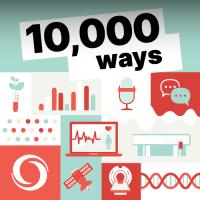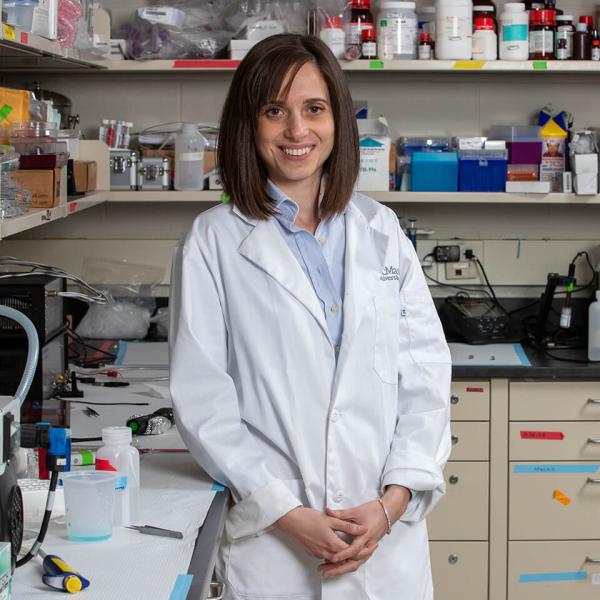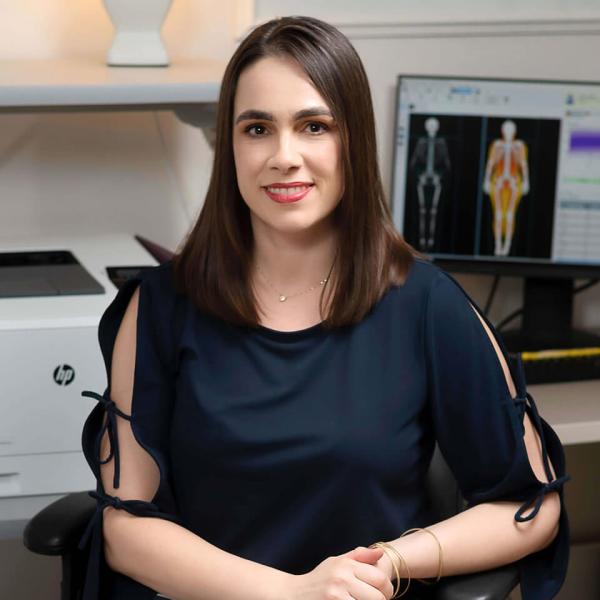Host:
This is a Canada Foundation for Innovation podcast.
(Music in)
Host:
Hello and welcome to 10,000 ways.
This is a podcast about curious researchers, leading edge science and the joys of discovery.
Anna Blakney:
I’m Anna Blakney. I’m an assistant professor at the University of British Columbia in the Michael Smith Laboratories and School of Biomedical Engineering and I am a bioengineer that studies RNA vaccines and therapies.
Host:
Our podcast gets its name from Thomas Edison who said,
“I have not failed. I’ve successfully found 10,000 ways that will not work.”
(Music out)
(Music in)
Blakney:
…with any vaccine, we’re trying to train your immune system to recognize a foreign pathogen or virus and we do this by training your immune system to recognize a certain protein, and there's loads of ways of getting a protein into your body so that we can train your immune system so we could use the virus itself. We can also make the protein itself, but instead of doing that, we use RNA, and we give you, the patient, the code to make the protein yourself and train your immune system in that way.
(Music out)
Host:
So, what exactly does RNA mean?
(Music in)
Most of us know, thanks in no small part to COVID-19, that RNA is associated with vaccines, but what you may not know is that it’s an acronym ribonucleic acid, which is a macromolecule or a polymer.
Another macromolecule which sounds very similar to RNA is DNA or deoxyribonucleic acid. DNA is like a master stack of genetic blueprints, which never leaves the architect’s nucleus and RNA is like a duplicate set of plans that go to the jobsite, outside of the nucleus where it generates proteins to help fight pathogens.
Blakney:
So, the DNA is the instructions for all the actions that can take place in your cells. It’s like the hard drive. Proteins are the actual effector molecules and RNA is the stepping-stone between DNA — all of the instructions, and the protein so it’s a specific code that codes for one specific protein that then carries out that action.
(Music out)
Host:
Historically, vaccines introduced a weakened or dead virus into the body which triggered an immune response. RNA vaccines can trigger a similar response but without actually introducing any sort of virus into the body.
(Music in)
Okay, so the part of my research right now that I’m super passionate about is thinking about how we can make RNA vaccines even more potent and use an even lower dose of RNA so anybody that’s gotten one of the COVID vaccines, very likely has had side effects from it, and there’s really beautiful data from the clinical trials that show that the side effects are directly proportional to the dose of RNA that we’re using and so we saw this from kind of the dose escalation trials where Moderna went up to 250 micrograms and they saw even more side effects when they used those higher doses. I think for RNA vaccines to be really functional for the future, for not just COVID, but for other vaccines, like the seasonal flu vaccine or other infectious diseases, we really need to minimize that dose and minimize the side effects that we see.
(Music out)
Host:
Anna’s passion for science can be traced back to her father and, “Take your daughter to work days.”
(Music in)
Blakney:
Yeah, let’s see, so, I’m a chemical engineer originally by training, and my dad is a chemical engineer, so I think that’s definitely where I got the idea from.
Host:
During high school, she spent four days at a summer camp sponsored by the University of Colorado, her dad’s alma mater, where she sampled a variety of engineering related demonstrations. A presentation on polymers helped catalyze Anna’s passion for research.
Blakney:
What really got me into engineering is honestly research because that was … I liked studying engineering and learning more about the science and math, but I didn’t really enjoy it until I did research and really understood, okay, this is how I can apply these theories and actually make things and do experiments and test things and that is what really kind of sealed the deal for me and made it super interesting.
Host:
After high school she went on to earn a Bachelor of Science in chemical and biological engineering which was then followed up by a PhD in bioengineering from the University of Washington. She continued her studies with a Research Fellowship in London and now she is an Assistant Professor in the Michael Smith Laboratories and School of Biomedical Engineering at the University of British Columbia.
(Music out)
Host:
While her dad may have provided the initial impetus for her professional trajectory there were others, later in life, who continued to provide motivation and inspiration.
(Music in)
Blakney:
As far as scientists that I really admire, I guess a few that I’ve been thinking about a lot lately, likely because of COVID, really is I guess the combination of Kati Karikó and Pieter Cullis and Drew Weissman who I think really made these big discoveries in the fields of RNA and lipid nanoparticles. I think the story of Katalin Karikó is really amazing, she’s gotten a lot of press and awards, and nothing makes me happier than seeing her recognized for all the work that she did.
Host:
Pieter Cullis, out of the University of British Columbia, is the delivery expert for the fragile messenger RNA vaccine. Drew Weissman, out of the University of Pennsylvania, is also an expert in messenger RNA, who casually met Kati one day at a photocopier.
Many years have passed since that serendipitous meeting and in 2021, Cullis, Weissman and Karikó all became co-recipients of the inaugural VinFuture Grand Prize which recognizes breakthrough research and more specifically, their “messenger RNA technology that paved the way for effective COVID-19 vaccines.”
(Music out)
Host:
This peer recognition, especially for Kati, has been a long time coming and it begins way back in 1985. She leaves her native Hungary due to lack of funding for her research. She moves to the States and eventually arrives at the University of Pennsylvania. In 1995, after six years with the university, she is academically demoted. No interest in RNA means no funding and she can find few who share in her convictions and beliefs.
(Music in)
Blakney:
She was doing this work for years, and it was at a time when it was really hard to get funding for RNA research. One, because everybody thought DNA was much more promising, and RNA was this really fragile molecule that wasn’t going to work out, but there hadn’t been a lot of proof-of-concept studies in it. Even though it was working for her, it was really hard to get funding for it. She continued to do this work even though it was such an uphill battle. It wasn’t in vogue like it is now, where everybody’s excited about RNA. It was like nobody thought it would work but her.
While others may have thrown in the towel, or turned off the proverbial Bunsen burner, Kati remained committed to the vast therapeutic potential of messenger RNA.
For her whole career, she’s just been under-recognized for her work, right? The whole field really uses these modified nucleotides now, and so it’s like this huge achievement, and I would say until the past year, there wasn’t really proper recognition for it so now that I see that she gets all these awards, and there’s articles in The New York Times about her …
So, something that I’ve just always really admired about her is the, I guess, passion and dedication that she had to this research throughout ... hitting that kind of ceiling and then continuing to do the research in the context of a company, and just, she really had a vision for it, I think, and made it happen.
(Music out)
(Music in)
Host:
There are many today who say that Kati and her colleagues should be co-recipients of a Nobel Prize in Chemistry. It’s hard to imagine though, even with her current success, how it might have felt to have been demoted and faced with a lack of interest time and time again.
Blakney:
So, I think as scientists you have to get used to failing all the time, and I think it’s generally viewed as it can be kind of crushing when you first experience that, because it’s viewed very negatively, right? Oh, you failed. You didn’t accomplish what you’d set out to do.
(Music out)
Host:
The name of our podcast references Thomas Edison’s quest for a practical light bulb or some say batteries. The exact derivation of the quote, “I’ve just found 10,000 ways that won’t work” is subject to speculation, but there’s one thing that’s not open to speculation and that’s that Thomas Edison was a very successful, serial, “Failure”
(Music in)
Blakney:
Right after finishing my PhD, I was really competent in certain things in biomaterials and drug delivery and then went to an immunology lab where I knew a lot less than every single grad student in that lab, but I was coming in as a post-doc, and you’re supposed to be kind of this more senior person. I spent basically a whole year learning more about immunology, learning more about RNA, creating this whole system. I was the first person in the lab to work on RNA vaccines, and so it was just so much troubleshooting and not having come from that background that after coming from the peak of your PhD where you’re just really productive, you can just crank out experiments and it kind of starts to feel like everything starts to work really well … I was at this point where I spent a year that was basically just like troubleshooting.
In science, actually failing is partially accomplishing what you set out to do, which is learning about the system, right? Failure is super important. It is … I like that quite a lot. I actually think that’s a great perspective, because often the experiments that fail, it’s actually what we learn the most about. I think that’s really important for scientists to learn and kind of get used to is you just have to be resilient. You might have to do things lots of times over and over before you finally get something to work and so I think it takes a certain personality type to do that.
(Music out)
Host:
Resilience and persistence are also integral parts of the scientific method. This process defines a question, makes predictions, gathers data, conducts analysis, and then draws a conclusion. Rinse and repeat, repeat, repeat if required ... sometimes for decades. For example …
(Music in)
Host:
In 1910, Canada recorded its first case of polio. By 1953 there was still no cure and nearly 9,000 cases. Two years later, in 1955, the Salk vaccine finally started to bring hope and relief. This relief, however, had taken 45 years of dedicated research.
Now let’s jump ahead to today. The apparent speed with which the COVID vaccines were created found some people questioning their safety and the long-term effects on health. They wondered, how such a fast-tracked remedy could be produced and tested so quickly and still be considered safe?
The challenge for researchers and healthcare professionals became how to convince the general population that the vaccines, which actually had been in development for decades, were indeed safe, side effects notwithstanding. The inertia associated with sharing this knowledge was not lost on the medical and research communities.
(Music out)
(Music in)
Blakney:
If you think about back before January 2020, how many scientists were aware of RNA vaccines or knew how they worked? Very few, right? And so, there’s just this gap between scientific progress and what the public knows about, so then, of course, when these vaccines get made, and they’re distributed and approved, and people are, “I have never heard of an RNA vaccine.” Of course, there’s going to be skepticism about it. I think the skepticism and what we call vaccine hesitancy is actually a really good thing. You should be questioning the things that you put into your body. We try to convince people of that all the time, right?
The downfall is that we’re not there to be able to educate people, or they don’t have a certain level of scientific literacy to be able to understand or interpret the data, and so I do think that’s where kind of the public engagement and outreach comes in, such that the scientists aren’t 20 years ahead in the education compared to the general public.
I actually think people are more interested and I guess enthusiastic about the science than maybe ever before in a way, like if you think about how much people have learned about viruses and vaccines and immunology and epidemiology over the past few years, just having the R-number thrown around in the general media, I think is amazing. People are starting to understand these things, so I think when there is that questioning and disconnect, it really is because of our failure as educators.
(Music out)
Host:
The Michael Smith Laboratories state that they are the place where, “Biotechnology research and educational outreach converge to inspire creative ideas for a better world.”
The United Nations also wants to create a better world. Team Halo, a collective of volunteer scientists and healthcare professionals, is a social media initiative designed, “To address COVID-19 vaccine concerns and misinformation.”
(Music in)
Blakney:
People want to learn more about RNA vaccines and science and see how you actually make these, and what it actually means to do an experiment and so I think we just need to be creative in the ways that we are communicating, right? As scientists, the most common way for us to communicate our work and results is to another scientist, right? In a presentation or a publication, and that’s all well and good professionally, but I think as far as having an impact on society, we need to think beyond that. I think social media is a good tool for it or can be. It’s also … there’s pros and cons out there as well but I think there’s lots of creative ways that we can try as educators to educate more than our students or the people at our university.
(Music out)
Host:
Young adults are having to navigate an extremely complex information ecosystem where they are inevitably exposed to anti-science information.
In 2021, the Canada Foundation for Innovation sponsored a Youth Science Survey and found that 71 percent of youth had received a vaccine and 67 percent strongly believed science supported the safety of the vaccines. This was good. Conversely, 73 percent of respondents also reported following at least one social media influencer who expressed anti-science views.
The influence of the influencers presented a difficult challenge for science communicators and educators: how to effectively reach those who do not have the tools, nor the interest, to fully understand science-related issues.
(Music in)
Blakney:
To me, it’s all quite experimental right now. I guess, anecdotally, I, during the pandemic, was recruited to this organization called Team Halo, which was started as a collaboration between the United Nations and the Vaccine Confidence Project, and the whole goal was to get scientists and clinicians who are working on COVID-19 just engaged with the general public and specifically over TikTok and so … that’s … when they randomly called me on my office phone one day, and I was, okay, it’s a weird time, but surely this is a scam, right? The United Nations just called me to start a TikTok account. I ended up meeting with them and doing it, and I now have a pretty large TikTok following. I have over 270,000 followers.
(Music out)
Host:
Anna has generated over 4 million views on her TikTok account ... The Team Halo TikTok site boasts over 272 million views. When Anna learned that Dolly Parton helped fund the Moderna vaccine …
(Music in)
Anna recorded a TikTok version of Parton’s song, “9 to 5” to help explain her research work.
(Anna TikTok audio with vocals)
(Lyrics)
Tumble out of bed and stumble to the kitchen.
Pour myself a cup of ambition, yawn and stretch
and try to save some lives.
Jump to my lab cuz this job is not boring.
Working on vaccines the world needs restoring
Folks need me on the job from 9 to 5.
Vaccines 9 to 5, what a way to make a living.
Working 9 to 5 and …
(Music out)
Anna’s assessment that people want to know more and learn more, cannot be dismissed.
(Music in)
Furthermore, viewer data from Team Halo also supports this broadband curiosity.
Blakney:
I think for me, it’s really the curiosity that drives it. I think this is true for a lot of researchers and scientists. To me, the most exciting thing is just having an idea and then being able to test it and then seeing what happens. There’s just always a question of whether something is going to work or not, and so, that to me is just the most motivating thing in science is being able to test out theories and see if they work and learn.
Host:
We all have different definitions of “success.”
(Music out)
For some it might mean fame. For others it might mean fortune. There’s speculation that both Winston Churchill and Abraham Lincoln are attributed to having said, “Success is going from failure to failure without losing enthusiasm.” It would be hard to challenge Anna’s enthusiasm and her definition of success is slightly different.
(Music in)
Blakney:
So, I guess I define success as being able to accomplish my goals and lift other people up in the process and I guess make the world a better place. So I know that’s quite vague, but that’s how I view it. I feel incredibly grateful to be in the position I am because it’s such a cool opportunity to be a professor and have a lab and get to have all these ideas and try them out and see what works and potentially make new medicines. It’s just a really incredible position to be into.
Host:
A recent post from the News & Star newspaper, The Cumberland News, quotes Anna as saying, “TikTok is all about inspiring creativity and bringing joy. My general approach is that people come for the entertainment but stay for the science.”
Blakney:
What I would like to contribute to is just making RNA more accessible for people. That’s what matters to me is being able to have a positive impact on human health because I think it is really a game-changing type of medicine and can impact many people, not just in Canada, but all over the world.
(Music out)
(Music in)
Host closing:
In 1985, Kati arrived in Philadelphia with her family and just over a thousand dollars smuggled out of Hungary in her daughter’s stuffed bear. Her belief in the power of RNA kept her going during the lean times and the multiple academic rejections. Eventually, her curiosity and persistence would pay off.
David Langer, an associate of Kati’s, is quoted in a New York Times article as having said,
“… her genius was a willingness to accept failure and keep trying ...”
Today Kati is a Senior VP at BioNTech who is at the forefront of leading-edge, vaccine science.
Anna is a superstar TikTok Doc who shares in Kati’s belief in the power and potential of RNA vaccines. She wants to share what she knows as well as her joy of discovery.
She sees social media as a bridge between those who know and those who want to know.
It’s also heartening to note that 70 percent of respondents to the CFI’S Youth Science Survey expressed the belief that science can be trusted because it is based on facts and not on opinions.
We’ll leave you to linger on the words of Thomas J. Watson who was an American industrialist. He grew International Business Machines or IBM into a technology giant. One day he was asked about his formula for success. This is what he had to say:
“Would you like me to give you a formula for success? Come closer and I’ll tell you. It’s quite simple, really: Double your rate of failure. You are thinking of failure as the enemy of success. But it isn’t at all. You can be discouraged by failure, or you can learn from it, so go ahead and make mistakes. Make all you can. Because remember that’s where you will find success.”
(Music dissolve)
10,000 Ways is produced in the studios of the Canada Foundation for Innovation.
The CFI is a non-profit corporation that invests in research infrastructure at Canadian universities, colleges, research hospitals and non-profit research institutions.
2022 is our 25th anniversary and over the course of the last 25 years we’ve funded over 11,000 projects and contributed more than nine billion dollars in infrastructure funding.
If you’re curious to learn more about the CFI, then please visit innovation dot ca. That’s …
I N N O V A T I O N dot C A.
I’m Greg Pilsworth. We’ll let the music play out. Thanks for listening. Bye bye.






